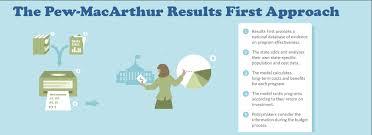Santa Cruz County Has Seen the Value of Results First
 The CSAC-Results First partnership is a joint effort
of CSAC under the umbrella of the California Counties Foundation,
and the Pew-MacArthur Results First Initiative (Results
First). Together, we provide tools and training to select
California counties as they engage in evidence-based
policymaking. The goal of CSAC-Results First is to support
California counties to make data-driven policy
decisions through the use of an innovative,
outcomes-focused, cost-benefit analysis. Together we are
assisting Santa Barbara, Santa Cruz, Fresno, Kern, Ventura and
Santa Clara Counties. Since 2017, CSAC has expanded to Nevada and
Solano Counties and will expand to two additional counties
by the end of 2018. Santa Cruz County joined Results First in
2013 right on the heels of AB109, the criminal justice
realignment. We asked Probation Chief Fernando Giraldo to discuss
how Results First is working in his county.
The CSAC-Results First partnership is a joint effort
of CSAC under the umbrella of the California Counties Foundation,
and the Pew-MacArthur Results First Initiative (Results
First). Together, we provide tools and training to select
California counties as they engage in evidence-based
policymaking. The goal of CSAC-Results First is to support
California counties to make data-driven policy
decisions through the use of an innovative,
outcomes-focused, cost-benefit analysis. Together we are
assisting Santa Barbara, Santa Cruz, Fresno, Kern, Ventura and
Santa Clara Counties. Since 2017, CSAC has expanded to Nevada and
Solano Counties and will expand to two additional counties
by the end of 2018. Santa Cruz County joined Results First in
2013 right on the heels of AB109, the criminal justice
realignment. We asked Probation Chief Fernando Giraldo to discuss
how Results First is working in his county.
What made you decide to try Results First in your county?
Our Board of Supervisors in Santa Cruz has increasing expectations across all Departments, that the contracts we have with local services providers include specific outcomes that are measurable and demonstrate success. The Board no longer wants to pay just for services; instead the board wants to pay for outcomes. The Board’s expectation has given the Department leverage, because they will not approve contracts that are not tied to specific outcomes.
What has Results First provided for the county?
We imagined an adult services and interventions delivery system that was driven by the criminogenic risk and needs for all Adults on probation. One of primary objectives of AB109 has been to provide cost effective evidenced based community supervision and treatment and intervention services. Results First aligned with this vision. The model has assisted the county in determining which investments will yield the best and most cost-effective results. Santa Cruz County Probation introduced an RFP process for their adult criminal justice contracts in 2015. Since then, we have populated the benefit-cost model for adult criminal justice and juvenile justice.
Why is using an RFP to contract for adult justice services so different?
In the past, we contracted with service providers and they applied their blanket approach to our local population of adult offenders. They provided the service, but there was no emphasis on outcomes. The RFP approach allows us to state the preferred outcomes ahead of time, and the service providers have to meet those outcomes.
One of the three primary goals of the Santa Cruz County Community Corrections Plan CCP was Effective Interventions. The CCP agreed that services provided to the AB109 population needed to be evidence based and proven to reduce recidivism. The CCP Plan incorporated specific language about using evidence based and cost effective practices. The RFP and resulting contracts with service providers are how the plan actually gets applied to the real world. A key factor in implementing realignment in Santa Cruz has been the presence of multiple criminal justice initiatives that link the CCP with highly regarded national organizations and apply cutting edge technical and evaluation tools to guide success in reducing recidivism. Local work with Results First is one example of this.
So now you are applying the same principles to the Juvenile Justice population. Why?
After completing our Adult Criminal Justice Services Results First Model, it was evident that we needed to do the same for juvenile services. As a Department, we wanted to ensure alignment across all divisions, and make consistent and informed decisions about which programs to support based on level of evidence and return on investment. Additionally, many of the providers for adult services, also serve our juvenile population, so it made sense to have similar expectations for both populations. Our youth and families deserve high quality and effective services.
And, we still have the increased expectations from the Board of Supervisors that requires that we identify and track specific outcomes. The Board also recently supported a major shift in how community programs are funded. For the first time an RFP was released to support community programs.
What is the biggest takeaway from using the RFP process?
The biggest takeaway from the RFP process is that our county is ready for this and expects this moving forward. We have increased local capacity over the past decade that has prepared service providers to respond to an RFP that requires a higher level of accountability to outcomes. But in addition, in developing the model, we developed a baseline cost comparison we can use moving forward. Participating in the Results First initiative allows the County to use public safety performance data and County costs to inform decisions about how resources are allocated. The County can identify and invest in effective programs, reduce recidivism, increase the success of youth on supervision, increase program referrals and generate public and stakeholder support.
How has it shaped Adult Criminal Justice and how to do you hope it will shape Juvenile Justice?
The RFP for Adults has been a game changer.By utilizing the results of assessed risks and needs of hundreds of cases, determining levels of services/dosage that need to occur in and out of custody and by honing in priority top services needs, our local interventions are shaped by demonstrated client needs and not by the demand of service providers. We expect that this will be the same for juvenile justice.












































